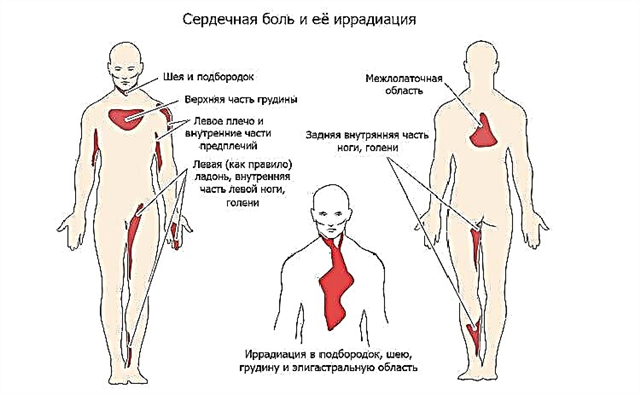Through numerous studies, scientists have established that there is primary and secondary hypertension. The second form is the most dangerous for the human body, because it is provoked by disorders of internal organs and the wrong release of hormones. The thyroid gland, which provokes high blood pressure, can cause various kinds of diseases, disrupting the hormonal balance in the body, so you need to consider how the thyroid gland and intravascular pressure are connected, and how to eliminate the problem that has arisen.
 The thyroid gland can shorten life by decades if you do not pay attention to symptoms that indicate a failure in its functionality for a long time. To prevent premature mortality, you should know what it is - thyroid hypertension.
The thyroid gland can shorten life by decades if you do not pay attention to symptoms that indicate a failure in its functionality for a long time. To prevent premature mortality, you should know what it is - thyroid hypertension.
Hypertension of the thyroid gland is a hormonal imbalance in the body, accompanied by high blood pressure. With deviations in the performance of this system, serious pathological diseases may appear, manifesting themselves not only clinically, but also externally.
How is intravascular pressure related to the thyroid gland?
The thyroid gland is an integral part of the endocrine system. It influences all organs, glands and body systems coordinating with it.
The thyroid gland interacts with:
- Apudocytes.
- Hypothalamus, pituitary gland, pineal gland.
- The ovaries in women and the testes in men.
- The adrenal glands and their glands.
- The pancreas.
As a result of the failure of its functionality, violations occur in all the above-described organs and systems. The adrenal glands are most affected, so they begin to secrete the wrong amount of thyroid hormones, provoking pathological diseases.
Thyroid hormones are responsible for the oxygen level in the blood plasma, the work of internal organs, glands, the development and growth of tissues, therefore, diseases that have arisen against the background of the thyroid gland and adrenal glands do not go unnoticed.
When the thyroid and adrenal glands begin to malfunction, the production of hormones increases: catecholamine, aldosterone, cortisol, adrenaline, and norepinephrine. They are capable of affecting the regulation of intravascular pressure, as a result of which high blood pressure arises, for no apparent reason.
If hormonal disturbances are ignored for a long time, then as a result, not only a symptom of high blood pressure may appear, but also a fatal outcome caused by diseases that appear against the background of hormonal imbalance. Therefore, the treatment of problems associated with the thyroid gland must be carried out in a timely manner.
What hormone increases intravascular pressure?
When the thyroid gland and other important systems begin to malfunction, various hormonal abnormalities appear. In addition, the follicular cells of the thyroid gland begin to produce active elements called triiodothyronine (T3) and thyroxine (T4). In normal amounts, they help a person adapt to an unfavorable environment (cold, sultry weather), but with an increased or decreased amount, they disrupt natural thermoregulation, cause tremors of the limbs.
Normally, the level of these elements should increase exclusively during physical exertion and unfavorable living conditions, but if deviations are recorded for no apparent reason, this is usually called hyperthyroidism.
With hyperthyroidism, thyroid hormones begin to narrow the intravascular lumen and tone the vessels, provoking increased pressure, creating a load on the cardiovascular system, disrupting the work of the heart.
In this case, the patient loses his ability to work due to such ailments:
- Frequent migraines.

- Fainting.
- Head spin.
- General weakness.
- Pain in the chest space.
- Rise in body temperature.
- Neuroses.
Having found such problems in oneself, it is required to immediately undergo a medical diagnosis in order to identify the causes that provoke a malfunction of the thyroid gland. Self-medication in this case is categorically unacceptable, because drug therapy should be aimed at blocking the receptor that is not performing its functions correctly.
Diagnosis of thyroid hypertension
To identify abnormalities that provoke high blood pressure, instrumental and laboratory studies are used to identify hormones that provoke intravascular abnormalities.
Instrumental diagnostics
The instrumental methods of studying thyroid hypertension include ultrasound. Carrying out the procedure, experts assess the following factors:
- The size of the thyroid gland, structure and shape.
- Density and uniformity.
- Whether there are neoplasms or tumors on it.
- What is the condition of the lymphatic and blood vessels of the thyroid gland?
These measures allow you to visually examine the thyroid gland, and characterize the disorders that have appeared.
Sometimes doctors use an MRI scan of the thyroid gland. The adoption of these measures indicates the difficulty of identifying the cause of the hormonal imbalance, because ultrasound does not show tumors less than 1 cm in size.
Laboratory diagnostics
The laboratory research technique allows you to find out what led to the occurrence of hormonal imbalance and increased blood pressure. To do this, you need to donate blood to the laboratory, and wait for the results. It is important to take a sample for research correctly, otherwise the diagnosis will give erroneous results. The doctor will tell you all about the rules for taking tests when prescribing a laboratory test.
Seeing violations in the results obtained, you should not interpret them yourself, because laboratories can use different reagents, units of measurement, as a result of which the analysis results may differ.
| Analysis | Norm | Decoding (with an increase in indicators) |
|---|---|---|
| TSH (thyroid stimulating hormone) | 0.5-4 μIU / ML | An increase in these values indicates overt, subclinical, or secondary hyperthyroidism. |
| T4 (Free thyroxine) | 0.9-1.7 pg / ml (11-22 pmol / l) | Confirms overt thyrotoxicosis |
| T3 (Free Triiodothyronine) | 3.6-8.1 pg / ml (5.5-12.2 pmol / l) | Manifest thyrotoxicosis |
| Thyroglobulin test | 1-2 ng / ml V | An increase indicates a thyroid adenoma or thyroiditis. With remission of cancer, it speaks of a resumption of the disease or the onset of an oncological process |
| AT-TPO (antibodies to thyroid peroxidase) | 31-99 IU / ml | Graves' disease, Hashimoto's thyroiditis, childbirth-provoked thyroid |
| AT-TG (antibodies to thyroglobulin) | More than 99 IU / l | Deviations occur when autoimmune processes of the thyroid gland occur |
Also, during the study, the age and weight of the patient are taken into account. During a health assessment, the doctor can identify the following endocrine diseases triggered by the thyroid gland:
- Pheochromocytoma is a disease caused by increased renal production of catecholamines.
- Hyperaldosteronism - appears as a result of an increase in the size of the adrenal glands. This disease releases an increased amount of aldosterone into the vessels, and the pressure rises.
- Acromegaly - occurs as a result of a pituitary tumor. Then a lot of growth hormone gets into the body.
- Hypercortisolism, or Itsenko-Cushing's syndrome, is characterized by an increased amount of cortisol production. It occurs due to a tumor of the adrenal glands or pituitary gland.
- Hyperparathyroidism is an increase in calcium in the hematopoietic system. It appears as a result of improper transportation of the mineral throughout the body (instead of penetrating into the bone tissue, the enzyme enters the circulatory system).
- Hyperthyroidism - occurs due to an increase in the production of hormones by the thyroid gland.
Each disease that falls into the above list is subject to immediate treatment, because most of the diseases from this list not only affect the systems and internal organs of a person, but also change its appearance: they change facial features, body shape. Refusal of medical therapy or ignoring the signs of the disease leads to premature death.
Treatment of hypertension of the thyroid gland
To reduce the high blood pressure triggered by the thyroid gland, it is required to undergo a study under the supervision of a specialist and listen to every medical recommendation.
Treatment of the thyroid gland is aimed at blocking the receptors that release excessive amounts of hormones. For this, the doctor prescribes special medications, selected in accordance.
Correct drug therapy will remove the source of thyroid disorders, and the pressure will return to normal. As a result, hormone supply is also normalized.
 To restore the functionality of the thyroid gland, the patient is recommended an iodine-containing diet. Recommended to consume:
To restore the functionality of the thyroid gland, the patient is recommended an iodine-containing diet. Recommended to consume:
- Seafood.
- Walnuts.
- Feijoa.
- Sweet pepper).
- Seaweed.
- Persimmon.
These foods are rich in various micro and macro elements, vitamins, and iodine. Thanks to their regular use, the optimal iodine balance is restored, contributing to the restoration of the functionality of the thyroid gland.
It is recommended not to abuse these products, and not to replace them with iodine solutions. These actions can oversaturate the body with useful substances, which will also negatively affect overall health, hormonal imbalance and intravascular pressure.
When consuming products containing iodine, the iodine balance should be monitored. To find out if the body needs such foods, a test is required:
- Spread iodine on an egg-sized circle on your hand and watch how soon the iodine figure disappears.
- If iodine has not been absorbed in 24 hours, then a person should not focus on restoring iodine balance.
Consequently, the thyroid gland takes an active part in the performance of internal organs, and its deviations can disrupt their work. To reduce the risk of a malfunction in the functionality of the thyroid gland, it is recommended to regularly monitor the presence of iodine in the body, and if abnormalities are found, urgently take action. Treatment should be carried out exclusively under the supervision of a doctor. A timely established hormonal imbalance and the correct prescription of the medication will reduce the cost of treatment, as well as quickly relieve symptoms indicative of hormonal disorders, including thyroid hypertension.




